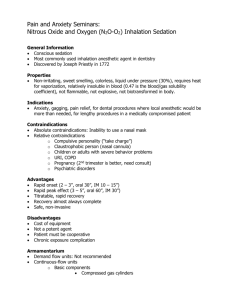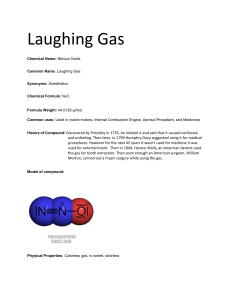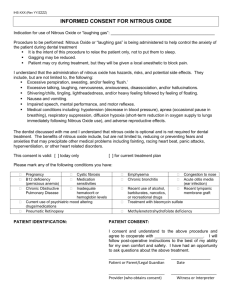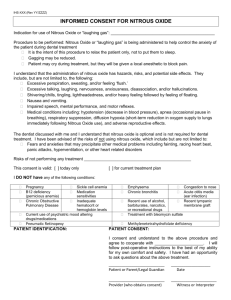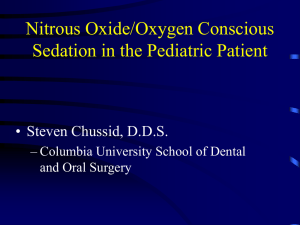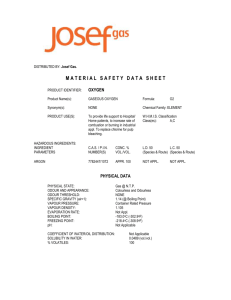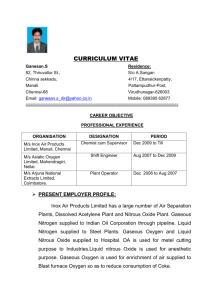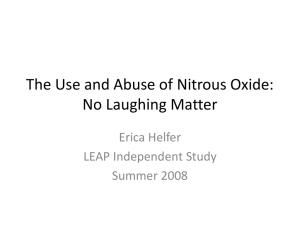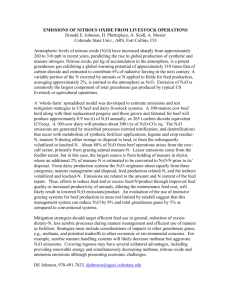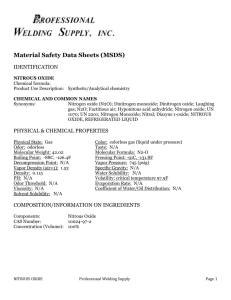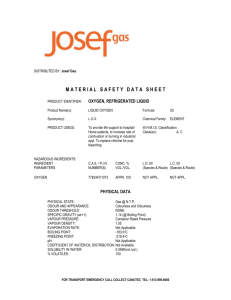nitrous oxide
advertisement
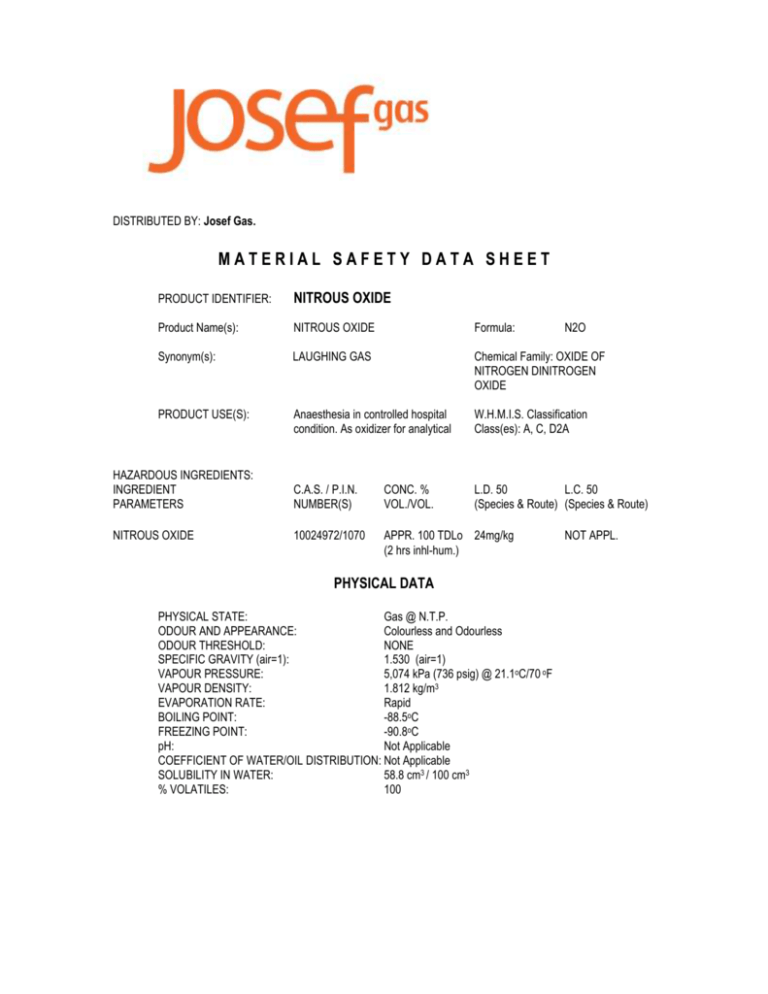
DISTRIBUTED BY: Josef Gas. MATERIAL SAFETY DATA SHEET PRODUCT IDENTIFIER: NITROUS OXIDE Product Name(s): NITROUS OXIDE Formula: Synonym(s): LAUGHING GAS Chemical Family: OXIDE OF NITROGEN DINITROGEN OXIDE PRODUCT USE(S): Anaesthesia in controlled hospital condition. As oxidizer for analytical W.H.M.I.S. Classification Class(es): A, C, D2A HAZARDOUS INGREDIENTS: INGREDIENT PARAMETERS C.A.S. / P.I.N. NUMBER(S) CONC. % VOL./VOL. L.D. 50 L.C. 50 (Species & Route) (Species & Route) NITROUS OXIDE 10024972/1070 APPR. 100 TDLo 24mg/kg (2 hrs inhl-hum.) PHYSICAL DATA PHYSICAL STATE: Gas @ N.T.P. ODOUR AND APPEARANCE: Colourless and Odourless ODOUR THRESHOLD: NONE SPECIFIC GRAVITY (air=1): 1.530 (air=1) VAPOUR PRESSURE: 5,074 kPa (736 psig) @ 21.1oC/70 oF VAPOUR DENSITY: 1.812 kg/m3 EVAPORATION RATE: Rapid BOILING POINT: -88.5oC FREEZING POINT: -90.8oC pH: Not Applicable COEFFICIENT OF WATER/OIL DISTRIBUTION: Not Applicable SOLUBILITY IN WATER: 58.8 cm3 / 100 cm3 % VOLATILES: 100 N2O NOT APPL. FOR TRANSPORT EMERGENCY CALL COLLECT CANUTEC TEL: 1-613-996-6666 UYI 111-1 FIRE OR EXPLOSION HAZARDS CONDITIONS OF FLAMMABILITY: MEANS OF EXTINCTION: FLASH POINT: UPPER FLAMMABLE LIMIT: NONE AUTOIGNITION TEMPERATURE: HAZARDOUS COMBUSTION PRODUCTS: SENSITIVITY TO MECHANICAL IMPACT: SENSITIVITY TO STATIC DISCHARGE: SPECIAL PROCEDURES: NONE. Nitrous Oxide will support and sustain combustion of other materials. Some materials that do not burn in air may ignite in presence of N2O. Cool containers with water spray. Extinguish surrounding fires. N2O will not burn but it will sustain the combustion of surrounding materials. NONE NONE LOWER FLAMMABLE LIMIT: NONE NONE NONE NONE NONE Evacuate areas where a leak or a spill is present. Fight surrounding fires as the case may be. Do not use water on the source of leak to avoid ice formation that may obstruct the operation of Safety Relief Devices. REACTIVITY DATA CONDITIONS OF CHEMICAL UNSTABILITY: INCOMPATIBILITY: CONDITIONS OF REACTIVITY: HAZARDOUS DECOMPOSITION PRODUCTS: NONE All combustible, organic material, All reducing agents. Alkali metals. N2O mat react readily with organic compounds. NO, NO2. TOXICOLOGICAL PROPERTIES ROUTE OF ENTRY SKIN (CONTACT): SKIN (ABSORPTION): EYE CONTACT: INHALATION: INGESTION: YES NO YES YES NO EFFECTS OF ACUTE EXPOSURE: Exposure to N2O at 10% may induce analgesia (reduce sensitivity to pain), at higher concentration euphoria, loss of Coordination and loss of consciousness may occur. At concentrations approaching 100% respiratory arrest may occur. At concentrations approaching 100% respiratory arrest may occur due to the lack of oxygen, followed by death. Therapeutic uses of N2O should be supervised by competent medical personnel. EFFECTS OF CHRONIC EXPOSURE: Prolonged occupational exposure of abuse has resulted in neurologic effects such as loss of pain, balance, impotence, Reduction in motor and audiovisual skills. Recovery may occur in months but damages may be permanent. Kidney and liver disorders have been reported along with fetal malformations and spontaneous abortions. EXPOSURE LIMITS: IRRITANCY: SENSITIZATION: CARCINOGENICITY: REPRODUCTIVE TOXICITY: TERATOGENICITY: MUTAGENICITY: TOXIC SYNERGISTIC PRODUCTS: T.L.V.\T.W.A. 50 ppm. (25 ppm for operating rooms: OSHA) NONE NONE NOT AVAILABLE TCLo 20%/8hrs/day 28 days male rat. TCLo 5,000 ppm 6 hours inhl-rat (1 – 19 pregn.) Chromosome loss in Drosophila after 6 mins @ 99%. NONE UYI 109-3 FIRST AID EYE: INGESTION: INHALATION: SKIN: Escaping Gas may harm the unprotected eye if delivered at pressures higher than atmospheric. Obtain medical attention if damages are suspected or present. Not applicable Move victim to fresh air if possible. Obtain medical attention. If breathing has stopped , administer C.P.R. If breathing is difficult give oxygen. Contact with cold liquid or vapours may cause frostbite. Treat frostbite if present. Obtain medical attention. PREVENTIVE MEASURES PERSONAL PROTECTION EYE: HAND: FEET: CLOTHING: RESPIRATOR: Safety glasses or goggles to protect from accidental deliveries (leaks) under pressure. Not applicable. Safety footwear where applicable. Long sleeves, trousers recommended. Not applicable ENGINEERING CONTROLS: Provide ventilation. Keep oil, grease, and combustible materials away. SPILL AND LEAK PROCEDURE: Remove all source of ignition. Clear the area. Spills on combustible surfaces may cause a fire hazard. Try to stop the leak at source if without risk. Gas will dissipate depending on the site/area ventilation. Verify oxygen concentration prior to re-entry. WASTE DISPOSAL: No wastes may be generated other than empty containers. HANDLING PROCEDURES & EQUIPMENT: Use in ventilated areas. Keep away from Oil, Grease, Combustible, Flammable materials. Use appropriate carts for moving containers. Secure container when in use. Close the container valve when NOT in use, or when empty. Secure (restrain) during transporation or use. STORAGE REQUIREMENTS: Store in well ventilated areas. Keep away from sources of ignition. Store at temperatures below 52 oC. SPECIAL SHIPPING INFORMATION: Transport upright in well-ventilated vehicle. Do not transport in trunk of enclosed vehicle. Commercial (cylinders) quantities may NOT be transported in passenger compartments. T.D.G. SHIPPING NAME: T.D.G. P.I.N. / U.N. : Nitrous Oxide 1070 PREPARED BY: TEL: EFFECTIVE DATE: JOSEF GAS (416) 658-1212 AUGUST 2014 T.D.G. CLASSIFICATION CLASS(ES): 2.2 (5.1)
